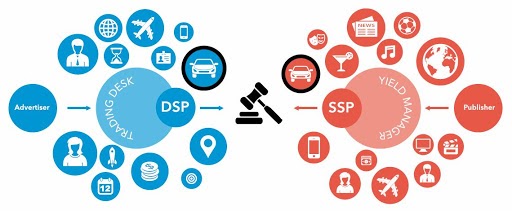What is really a Demand-Side Platform (DSP)?
A Demand-Side Platform (DSP) can be a software platform that allows advertisers to automate the process of buying digital ad inventory. DSPs supply a centralized interface where advertisers can buying ad space across various publishers and ad exchanges in real-time, making the entire process of purchasing ads better and effective.

Key Features of DSPs:
Real-Time Bidding (RTB): DSPs use real-time bidding to purchase ad space. Advertisers set their audience, budget, and bid, as well as the DSP automatically participates in auctions across multiple ad exchanges. If the bid wins, the ad is easily displayed towards the user.
Audience Targeting: DSPs allow advertisers to target specific audiences determined by various parameters like demographics, location, behavior, and interests. This helps to ensure that ads are shown for the most relevant users, increasing the chances of conversion.
Cross-Channel Advertising: DSPs enable advertisers to run campaigns across multiple channels, including display, video, mobile, and social media marketing. This multi-channel approach helps reach a broader audience and reinforce brand messaging across different platforms.
Data Integration: DSPs integrate with assorted data management platforms (DMPs) and third-party data providers, allowing advertisers to leverage detailed user data for more precise targeting.
Campaign Optimization: DSPs offer advanced analytics and reporting tools that really help advertisers monitor campaign performance in real-time. Advertisers can adjust bids, targeting, and creatives on the fly to optimize results.
What is often a Supply-Side Platform (SSP)?
A Supply-Side Platform (SSP) is a software platform used by publishers to automate the management, sale, and optimization of these ad inventory. SSPs connect publishers with multiple ad exchanges, demand-side platforms, and ad networks, enabling these phones sell their ad space on the highest bidder in real-time.
Key Features of SSPs:
Inventory Management: SSPs help publishers manage their available ad space, allowing the crooks to categorize and package inventory determined by various criteria like audience, content type, and ad format.
Yield Optimization: SSPs use algorithms to optimize the pricing and allocation of ad inventory. By analyzing market demand and historical data, SSPs make sure that publishers maximize revenue from other available ad space.
Real-Time Bidding (RTB): Like DSPs, SSPs participate in real-time bidding auctions, where multiple advertisers bid for available ad impressions. SSPs present the very best bid to the publisher, who is able to then elect to accept or reject the offer.
Access to Multiple Demand Sources: SSPs connect publishers having a wide range of demand sources, including DSPs, ad networks, and direct advertisers. This broad access increases competition for inventory and can lead to higher revenue for publishers.
Ad Quality Control: SSPs provide tools for publishers to manipulate the quality of ads displayed on their sites. This includes filtering out low-quality or inappropriate ads and making certain ads meet the publisher's standards for content and design.
DSP vs. SSP: Key Differences
While DSPs and SSPs both facilitate programmatic advertising, they operate on opposite sides of the market, serving different purposes and users.
Primary Users:
DSP: Used primarily by advertisers, media buyers, and agencies to buy ad inventory across various publishers and platforms.
SSP: Used by publishers to handle, sell, and optimize their available ad space to attract the greatest bidding advertisers.
Objective:
DSP: The main goal of a DSP is to help advertisers find and purchase the most relevant ad space on the best possible price, targeting specific audiences all night . campaign objectives.
SSP: The primary objective of your SSP would be to help publishers maximize the revenue generated from their ad inventory by connecting them with the very best paying advertisers.
Data Usage:
DSP: DSPs use data to help advertisers target specific audience segments. This data-driven approach enables more precise and effective ad placements.
SSP: SSPs use data to research and optimize the need for ad inventory. By understanding demand trends, SSPs can help publishers set competitive prices and maximize their yield.
Bidder vs. Seller:
DSP: Acts because the bidder inside ad auction process, representing the interests from the advertiser and bidding on ad space in real-time.
SSP: Acts because seller, managing the auction process and presenting ad inventory to potential customers through various demand channels.
Control:
DSP: Advertisers have complete control over each campaign, including targeting, budget, creative assets, and bidding strategies.
SSP: Publishers have total control over their ad inventory, including pricing, ad placement, and quality controls.
How DSPs and SSPs Work Together
Despite their differences, DSPs and SSPs are two sides from the same coin inside the programmatic advertising ecosystem. They communicate to facilitate the selling and buying of ad space in the efficient, automated manner.
The Process: When a user visits an online site or app, an SSP sends a request to varied ad exchanges, where DSPs invest in the available ad space. The highest bid is accepted, along with the corresponding ad is displayed towards the user—all in milliseconds. This process is repeated vast amounts of times a day across the internet, powering the digital advertising industry.
Mutual Benefits: DSPs take advantage of access to a number of inventory across multiple publishers, while SSPs take advantage of access to an extensive pool of demand from various advertisers. This mutual relationship drives the efficiency and effectiveness of programmatic advertising.
Understanding the differences between DSPs and SSPs is crucial for navigating the complex whole world of programmatic advertising. DSPs empower advertisers to achieve their target audiences with precision and efficiency, while SSPs help publishers maximize the value of these ad inventory. Together, they from the backbone of the modern digital advertising ecosystem, enabling seamless, real-time transactions that drive latest results for both sides. As the digital landscape is constantly on the evolve, the roles of DSPs and SSPs may become more intertwined, further enhancing the capabilities and reach of programmatic advertising.